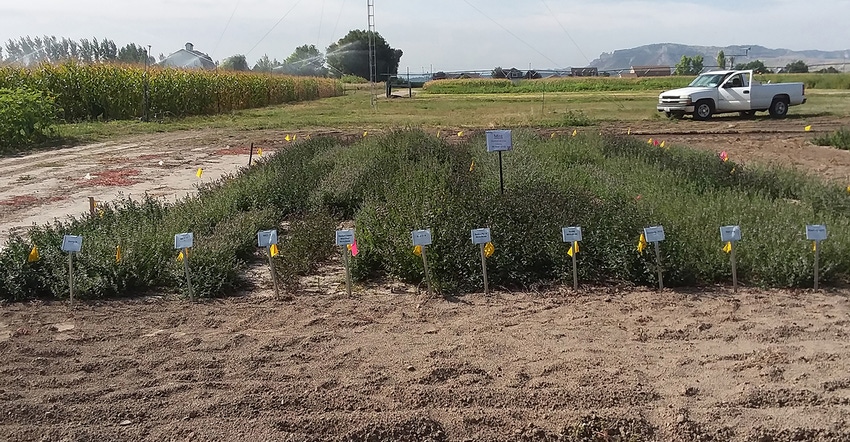March 12, 2020

By Dipak Santra and Dave Ostdiek
Mint is not commercially grown in Nebraska on a large scale yet — there are less than 500 acres — but a project at the University of Nebraska Panhandle Research and Extension Center in Scottsbluff is aimed at providing answers about whether farmers could grow it here, and which varieties might grow best.
A three-year project to identify the best mint varieties for western Nebraska began in 2018 and is scheduled to continue through the 2020 growing season. The project is funded by a Nebraska Department of Agriculture Specialty Crop Block Grant, and is carried out in collaboration with Dr. Mahesh Pattabiraman, associate professor of organic chemistry at the University of Nebraska-Kearney.
Mint is a genus of 25 species of fragrant herbs native to Eurasia, North America, southern Africa and Australia. Some species, particularly peppermint and spearmint, are used as flavorings for foods (including candy and gum) and for liqueur and dentrifrices.
The essential oils of mints, contained in the leaves and stems, are used as scents in perfumery. Some species are commonly used in herbal medicine.
Two types of mint are produced commercially, peppermint and spearmint. Three countries are the major producers of mint: the U.S., India and China. The U.S. is a leader in peppermint oil production (70% of the world production).
Peppermint production in the U.S. is concentrated in the northwestern states of Oregon, Washington and Idaho, which account for 84% of U.S. mint production. Acres harvested ranged from 20,800 acres to 25,800 acres during 2013-18.
The total value of U.S. mint is about $200 million. The price per pound received by growers in 2018 was $19.80 for peppermint and $16.80 for spearmint.
Western Nebraska’s climate is similar to the semiarid regions of those states, so commercial production of high-quality mint oil is possible here. But there are unknowns for producing mint in the Nebraska Panhandle: Which varieties are best adapted? What are their characteristics? Which have the most potential for high-yielding biomass and high oil content?
Neither peppermint nor spearmint are native to western Nebraska, but spearmint is native to America.
In 2018, the first year of the mint project in Scottsbluff, University of Nebraska-Lincoln research crews planted 14 mint varieties — including six peppermint varieties, six spearmint varieties and two intermediate mint varieties. They were planted with 22-inch row spacing and a distance of 5 inches between plants.
The varieties were planted in late May through the first week in June, similar to dry edible beans. The mint was grown under irrigation using standard production methods. Data was collected related to plant growth and development (plant vigor, flowering time, plant height, pigmentation, any disease and so on).
Differences were noted between the two types of mint. Spearmint’s growth rate was almost twice that of peppermint, and it flowered around mid-June. Peppermint flowered around the end of July. Peppermint has pigmented leaves (purple), while spearmint does not.
Spearmint was harvested twice, the first time in early July, the second time in late September. Peppermint was harvested once, in August.
Harvested samples were dried and weighed to determine dry biomass yield. Subsamples of dry biomass were used to analyze mint oil, both quantity and quality. There was a significant yield difference among the varieties.
Among the findings of the data from the first two years of study:
All the mint varieties had a similar height pattern, ranging from 7 to 13 inches.
Mint can grow in an aggressive manner with basal shoots, thus row spacing can be one important aspect to consider during planting
Among the varieties planted, in peppermint, Todd mint had the highest menthol content. In spearmint, Scotch had the highest carvone content.
Menthol is the primary oil type for peppermint; carvone is the primary oil type of spearmint.
The existing small acreage of mint farm in the North Platte Valley is planted with a single spearmint and single peppermint variety, but it is unknown whether those specific varieties are the best for western Nebraska.
There is no data on which mint variety is the best for western Nebraska's climate. Therefore, results of this project will provide choices for selecting the best variety.
The next step will be optimizing nitrogen fertilizer management in collaboration with Bijesh Maharjan, soil and nutrient management specialist at the Panhandle Center. Mint is grown in well-drained soil, with nitrogen input as high as 294 pounds per acre and high water input.
This warrants a need to optimize N management in spearmint production in a way that will not only economically benefit producers, but also reduce potential nitrate-N loss through leaching in such a high-input system.
With availability of the best mint variety and optimal nitrogen management practices, the mint production in the region potentially will be profitable and sustainable.
Santra is an alternative crops breeding specialist, and Ostdiek is a communications associate at the University of Nebraska's Panhandle Research and Extension Center.
Source: Panhandle Research and Extension Center, which is solely responsible for the information provided and is wholly owned by the source. Informa Business Media and all its subsidiaries are not responsible for any of the content contained in this information asset.
You May Also Like




